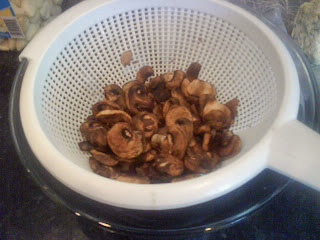A review of
Heston Blumenthal: In Search of Perfection: Reinventing Kitchen Classics
.
Yep, it's Alton Brown on steroids.
I am a big fan of Alton Brown, and now I have found an even greater hero: Heston!
Just one thing though - he scares the living daylights out of me - if he weren't in a kitchen the only safe place for him is a padded lockdown.

I've made about two (more now) of the recipes so far, and I am looking forward to doing more. I have already ordered
Further Adventures in Search of Perfection
and pre-ordered his (very expensive)
The Big Fat Duck Cookbook
.
On his Fish and Chips:
Alas, no turbot on the US West Coast. Maybe no-one understands me because I use the English pronunciation (like fillet) - pronouncing both t's, unlike the American/French with a silent 2nd t.
I used halibut - love halibut.
His batter method is unnecessarily long-winded. I used a 5lb CO2 bottle with a special adapter for a standard plastic soda bottle instead of a soda siphon, With this exception completed his recipe and found where the book's true value is:
It didn't work for me, but it allowed me to see where to improve my beer batter recipe that I have used for years.
I now use 2/3 beer, 1/3 vodka, (plus a large splash of lemon juice and paprika).
And now I make very small batter batches, don't wait for the every last lump to disappear, batter immediately, and straight in the fryer - all as fast as possible. It is a tangible improvement - thanks Heston!
His chips (french fries) again has what to my unrefined palette is an unnecessary step - the initial boil.
Instead I now extend my initial low temp (300F) fry to 10 mins, and cool completely in the 'fridge.
But I found an improvement - I use a little portable fan to blow over the fries to hurry along the dehydration process - all thanks to Heston!
I also tried the entire steak recipe which was 100% great, and the mushroom ketchup is to die for!
The recipe calls for the meat to cook at (exactly) 120F for 24 hours. Sounds dangerous? Well it hasn't been for me, and I've tried it three times (more now).
This lengthy warming allows enzymes to break down the other proteins in the meat, tenderizing it and adding flavor.
One of these enzymes is Glucuronidase.
Another is cathepsin. There are approximately a dozen cathepsins, which are distinguished by their structure and which proteins they cleave.
The Troponin protein tri-complex and the Actin, Myosin, kinase, Titin (largest), Dynein, Calcineurin and tropomyosin proteins are some of the muscle proteins that are broken down. For example, Actin starts to degrade as the meat passes upwards of 70F (20C).
The reason that Heston sears the meat before the long 120F slow cook (and I know because I did it) is that the Maillard reaction flavors from the sear spend that time permeating through the meat.
Do I care that his reasoning is off at a tangent? NO.
You know why? Because it is the best damn tasting steak I have ever made. Good enough?
And if he tests 5 varieties of potatoes to get the best roast potato, yet doesn't draw a sufficiently tight logical line to satisfy Mr J. Alt, I don't care either. The man has sufficient bone fides for me to trust his judgement and conclusions.
And you know why I doubly don't care? I can't get Maris Pipers in the U.S. anyway!
I used his method of trying every potato I could get my hands on and made my own judgement. *
Which is what any reader of these reviews should also do.
I recommend this book.
Kevin
* I decided on White Rose. Thanks yet again, Heston!
Featured:












